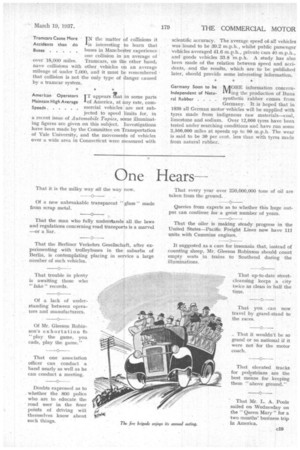Passing Comments
Page 68

Page 69

If you've noticed an error in this article please click here to report it so we can fix it.
Why Not 30 m.p.h. wAVING played a profor all Commercial "minent part in the success
Vehicles ? ful efforts to obtain concessions regarding the legal maximum weights of steam wagons, the Commercial Motor Users Association is continuing its activities in the direction of securing that the legal maximttm speed of a heavy motorcar equipped "with pneumatic tyres and efficient brakes shall be increased to 30 m.p.h. The modern machine is perfectly safe at speeds well in excess of this figure, and this move is overdue.
Important Prizes to WE referred recently to the Promote Progress in fact that welding is becom
Welding . . . . ing a science, and one of the richest awards ever established for competition in the mechanical field has just been announced by The James F. Lincoln Arc Welding Foundation, created late in 1936 by the Lincoln Electric Co., Cleveland, Ohio, which is affiliated with the Lincoln Electric Co., Ltd., Welwyn Garden City, Herb, England. This is to stimulate scientific study c18 and research in the use of arc welding, and 200,000 dollars will be distributed in 446 prizes, the highest prize being '13,700 dollars. It is notable that what is known as the automotive division comes first of the eleven mentioned. Participants must submit their papers not later than June 1, 1938. Rules can be obtained from Mr. A. F. Davis, P.O. Box 5728, Cleveland.
TROUBLE is occasionally I experienced by contractors using Pegson rammers in starting them up in the morning. This useful tool may have functioned perfectly all day, but after a night's rest may refuse to come to life again. A common cause is that the petrol, which is contained in the base, becomes hot and while standing loses by evaporation its most volatile constituents. If it be drained out after use and new fuel put in before starting, no trouble should be experienced. A similar difficulty long ago used to baffle drivers of vehicles with surface carburetters. Vaporizing Difficulty with Popular Contractor's Appliance . • Tramcars Cause More TN the matter of collisions it Accidents than do is interesting to learn that
Buses buses in Mancheiter experience
one collision in Ian average of over 18,000 miles. Tramcars, on the other hand; nave collisions with other, vehicles On an average mileage of under 7,000, and it must be remembered that collision is not the only type of danger caused by a tramcar system.
I T appears at in some parts of America, at any rate, commercial vehicles are not subjected to speed limits for, in a recent issue of Automobile Topics, some illuminating figures are given on this subject. Investigations have been made by the Committee on Transportation of Yale University, and the movements of vehicles over a wide area in Connecticut were measured with
American Operators Maintain High Average Speeds.
scientific accuracy. The average speed of all vehicles was found to be 39.2 m.p.h., whilst public passenger vehicles averaged 41.6 m.p.h., private cars 40 m.p.h., and goods vehicles 33.8 m.p.h. A study has also been made of the relation between speed and accidents, and the results, which are to be published later, should provide some interesting information.
Germany Soon to be ,AORE information concern Independent NatuI Yling the production of Buna ral Rubber . . . synthetic rubber comes from Germany. It is hoped that in 1938 all German motor. vehicles will be supplied with tyres made from indigenous raw materials—coal, limestone and sodium. Over 12,000 tyres have been tested under searching conditions and have run some 2,500,000 miles at speeds up to 90 m.p.h. The wear is said to be 30 per cent, less than with tyres made from natural rubber.
























































































































































